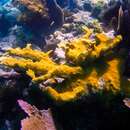en
names in breadcrumbs


"Elkhorn coral, like many corals, receive most of their energy and oxygen from symbiotic organisms called zooxanthellae." (NOAA Fisheries OPR)
"Elkhorn coral is found on coral reefs in southern Florida, the Bahamas, and throughout the Caribbean. Its northern limit is Biscayne National Park, Florida, and it extends south to Venezuela; it is not found in Bermuda. Once found in continuous stands that extended along the front side of most coral reefs, the characteristic "Acropora palmata zone" supported a diverse assemblage of other invertebrates and fish. These zones have been largely transformed into rubble fields with few, isolated living colonies." (NOAA Fisheries OPR)
"Over the last 10,000 years, elkhorn coral has been one of the three most important Caribbean corals contributing to reef growth and development and providing essential fish habitat." (NOAA Fisheries OPR)
"Elkhorn coral was formerly the dominant species in shallow water (3 ft-16 ft (1-5 m) deep) throughout the Caribbean and on the Florida Reef Tract, forming extensive, densely aggregated thickets (stands) in areas of heavy surf. Coral colonies prefer exposed reef crest and fore reef environments in depths of less than 20 feet (6 m), although isolated corals may occur to 65 feet (20 m)." (NOAA Fisheries OPR)
"NMFS finalized the ESA listing of elkhorn and staghorn coral on May 4, 2006 (71 FR 26852). NMFS designated critical habitat for elkhorn and staghorn corals in November 2008." (NOAA Fisheries OPR)
"Like counting rings in the trunk of a tree, the age of corals can be determined by examining coral growth rings." (NOAA Fisheries OPR)
"Florida Keys National Marine Sanctuary (FKNMS), the largest coral reef management entity in the region, has developed a management plan for the Sanctuary's corals that includes protective activities, such as zoning, channel markings, and restoration efforts.
Restoration activities have included efforts to re-attach Acropora fragments generated by ship groundings and hurricane events; these efforts have had mixed success. Similar efforts to re-attach coral fragments have also been made in Puerto Rico and the U.S. Virgin Islands.
Other restoration efforts have included attempts to culture and settle coral larvae with very limited success. New techniques for restoring Acropora are currently being pursued. Such new techniques involve enhancing sexual recruitment, reestablishing ecological roles within reef systems (e.g. herbivorous urchins), and other methods for controlling predators and disease.
In 1998, the United States Coral Reef Task Force was established by Presidential Executive Order 13089 to coordinate and strengthen efforts for protecting coral reef ecosystems. The Task Force is co-chaired by the Departments of Commerce and Interior, and includes leaders of 12 federal agencies, seven U.S. states and territories, and three freely associated states. In 2002, the Task Force adopted a resolution calling for the development of Local Action Strategies, which are locally-driven plans for collaborative and cooperative action among federal, state, territory, and non-governmental partners to reduce key threats on valuable coral reef resources. Three Local Action Strategies have been developed within the range of elkhorn coral for Florida, Puerto Rico, and the U.S. Virgin Islands. These strategies are underway and will be implemented over a three-year period (FY2005-2007)."
"The coral larvae (planula) live in the plankton for several days until finding a suitable area to settle, but very few larvae survive to settle and metamorphose into new colonies. The preponderance of asexual reproduction in this species raises the possibility that genetic diversity may be very low in the remnant populations." (NOAA Fisheries OPR)
"The dominant mode of reproduction for elkhorn coral is asexual fragmentation; this life history trait allows rapid population recovery from physical disturbances such as storms. However, this mode of reproduction makes recovery from disease or bleaching episodes (in which entire colonies or even entire stands are killed) very difficult. The large role of asexual reproduction for this species increases the likelihood that genetic diversity in the remnant populations may be very low. Scientists are becoming increasingly concerned for this species based on its demographic paramaters; specifically, how species recruitment and genetic diversity affect recovery potential." (NOAA Fisheries OPR)